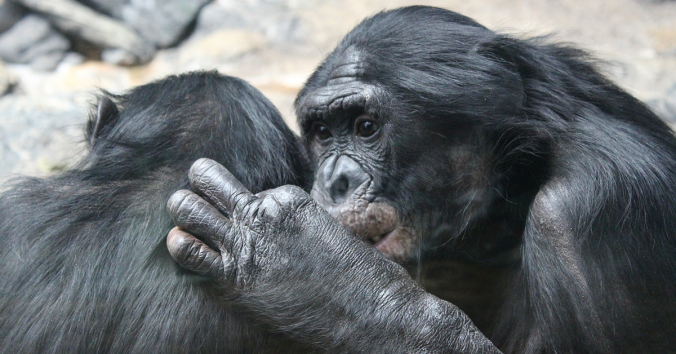What does it mean to be inspired by someone? Think of these inspired music albums where artists lovingly pay tribute to a great musician by making their own interpretations of the songs. These interpretations often express deep gratitude for the inspiration received from the musician. We can feel similar gratitude to inspiring people in many different areas.
Why are we inspired by inspiring people? Here is a tempting picture. The person who inspires us has something that we lack. To be inspired is to want what the inspiring person has: “I also want to be able to…”; “I want to be as good as…” and so on. That is why we imitate those who inspire us. That is why we train hard. By imitating, by practicing, the inspiring person’s abilities can be transferred to us who lack them.
This could be called a pneumatic picture of inspiration. The inspiring one is, so to speak, an air tank with overpressure. The rest of us are tanks with negative pressure. The pressure difference causes the inspiration. By imitating the inspiring person, the pressure difference is evened out. The pressure migrates from the inspiring to the inspired. We inhale the air that flows from the tank with overpressure.
This picture is certainly partly correct, but it is hardly the whole truth about inspiration. I am not a musician. There is a big difference in pressure between me and any musician. Why does this pressure difference not cause inspiration? Why do I not start imitating musicians, training hard so that some of the musicians’ overpressure is transferred to me?
The pneumatic picture is not the whole truth, other pictures of inspiration are possible. Here is one. Maybe inspiration is not aroused by difference, not by the fact that we lack what the inspiring person has. Perhaps inspiration is aroused by similarity, by the fact that we sense a deep affinity with the one who inspires us. When we are inspired, we recognize ourselves in the one who inspires us. We discover something we did not know about ourselves. Seeds that we did not know existed in us begin to sprout, when the inspiring person makes us aware that we have the same feeling, the same passion, the same creativity… At that moment, the inspiration is aroused in us.
In this alternative picture of inspiration, there is no transfer of abilities from the inspiring one to the inspired ones. Rather, the abilities grow spontaneously in the inspired ones themselves, when they sense their affinity with the inspiring one. In the inspiring person, this growth has already taken place. Creativity has had time to develop and take shape, so that the rest of us can recognize ourselves in it. This alternative image of inspiration also provides an alternative image of human history in different areas. We are familiar with historical representations of how predecessors inspired their successors, as if the abilities of the predecessors were transferred horizontally in time. In the alternative picture, history is not just horizontal. Above all, it has a vertical depth dimension in each of us. Growing takes place vertically in each new generation, much like seeds sprout in the earth and grow towards the sky. History is, in this alternative image, a series of vertical growing, where it is difficult to distinguish the living creativity in the depth dimension from the imitation on the surface.
Why am I writing a post about inspiration? Apart from the fact that it is inspiring to think about something as vital as inspiration, I want to show how unnoticed we make pictures of facts. We do not see that it is actually just pictures, which could be replaced by completely different pictures. I learned this from the philosopher Ludwig Wittgenstein, who inspired me to examine philosophical questions myself: questions which surprisingly often arise because we are captured in our images of things. Our captivity in certain images prevents us from seeing other possibilities and obvious facts.
In addition, I want to show that it really makes a difference if we are caught in our pictures of things or open to the possibility of completely different pictures. It has been a long time since I wrote about ape language research on this blog, but the attempt to teach apes human language is an example of what a huge difference it can make, if we free ourselves from a picture that prevents us from seeing the possibility of other pictures.
Attempts to teach apes human language were based on the first picture, which highlights the difference between the one who inspires and the one who is inspired. It was thought that because apes lack the language skills that we humans have, there is only one way to teach apes human language. We need to transfer the language skills horizontally to the apes, by training them. This “single” opportunity failed so clearly, and the failure was so well-documented, that only a few researchers were subsequently open to the results of a markedly more successful, at least as well-documented experiment, which was based on the alternative picture of inspiration.
In the alternative experiment, the researchers saw an opportunity that the first picture made it difficult to see. If apes and humans live together daily in a closely united group, so that they have opportunities to sense affinities with each other, then language seeds that we did not know existed in apes could be inspired to sprout and grow spontaneously in the apes themselves. Vertically within the apes, rather than through horizontal transmission, as when humans train animals. In fact, this alternative experiment was so successful that it resulted in a series of spontaneous language growths in apes. As time went on, new-born apes were inspired not only by the humans in the group, but also by the older apes whose linguistic creativity had taken shape.
If you want to read more about this unexpected possibility of inspiration between species, which suggests unexpected affinities, as when humans are inspired by each other, you will find a book reference below. I wrote the book a long time ago with William M. Fields and Sue Savage-Rumbaugh. Both have inspired me – for which I am deeply grateful – for example, in this blog post with its alternative picture of inspiration. That I mention the book again is because I hope that the time is ripe for philosophers, psychologists, anthropologists, educationalists, linguists, neuroscientists and many others to be inspired by the unexpected possibility of human-inspired linguistic creativity in our non-human relatives.
To finally connect the threads of music and ape language research, I can tell you that two great musicians, Paul McCartney and Peter Gabriel, have visited the language-inspired apes. Both of them played music with the apes and Peter Gabriel and Panbanisha even created a song together. Can we live without inspiration?

Written by…
Pär Segerdahl, Associate Professor at the Centre for Research Ethics & Bioethics and editor of the Ethics Blog.
Segerdahl, P., Fields, W. & Savage-Rumbaugh, S. 2005. Kanzi’s Primal Language. The Cultural Initiation of Primates into Language. Palgrave Macmillan
Segerdahl, P. 2017. Can an Ape Become Your Co-Author? Reflections on Becoming as a Presupposition of Teaching. In: A Companion to Wittgenstein on Education. Pedagogical Investigations. Peters, M. A. and Stickney, J. (Eds.). Singapore: Springer, pp. 539-553
We write about apes







Recent Comments